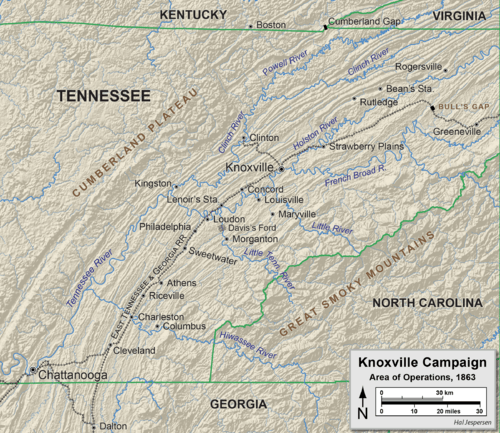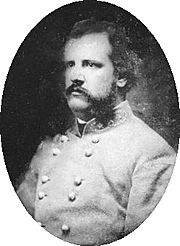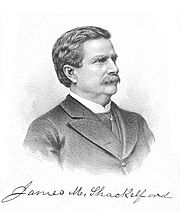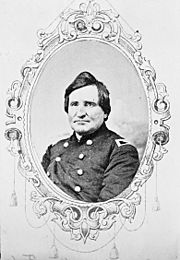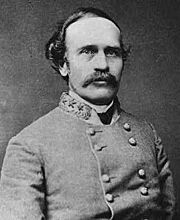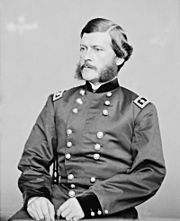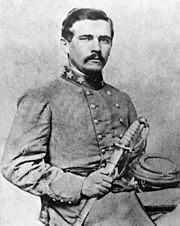Battle of Bean's Station facts for kids
Quick facts for kids Battle of Bean's Station |
|||||||
|---|---|---|---|---|---|---|---|
| Part of the American Civil War | |||||||
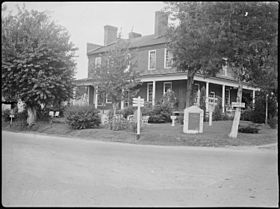 Bean Station Hotel before it was dismantled in 1941 to make way for the TVA's Cherokee Dam. |
|||||||
|
|||||||
| Belligerents | |||||||
| Commanders and leaders | |||||||
| Units involved | |||||||
| Confederate Forces in East Tennessee | Army of the Ohio | ||||||
| Strength | |||||||
| Total: 12,000 Engaged: 4,200 |
5,000 | ||||||
| Casualties and losses | |||||||
| 290–900 | 115–700 | ||||||
The Battle of Bean's Station happened on December 14, 1863. It was a fight during the American Civil War in Grainger County, Tennessee. This battle was part of the Knoxville campaign.
Confederate soldiers, led by Lieutenant General James Longstreet, attacked Union cavalry. The Union cavalry was commanded by Brigadier General James M. Shackelford. The fight lasted until nightfall. Longstreet's troops forced the Union soldiers to retreat.
Two Confederate cavalry groups tried to surround Shackelford's forces. They couldn't cut off the Union cavalry. However, one group captured 25 Union supply wagons. On December 15, Shackelford's cavalry met up with some Union infantry. They fought briefly with the Confederates before retreating again.
Longstreet's troops had been trying to capture Knoxville since November 19. This was called the Siege of Knoxville. On December 4, a larger Union army arrived and forced Longstreet to retreat. He went northeast to Rogersville. The Union forces followed him.
Longstreet learned that most of the Union army had left the area. So, he decided to attack again. He planned to surround and defeat Shackelford's cavalry. But the Union cavalry fought hard. The Confederate plan to trap them didn't work. On December 16, Shackelford joined the main Union army. Longstreet then pulled his troops back northeast.
Contents
Why the Battle Happened
The Big Picture
Even though East Tennessee was part of the Confederacy, many people there supported the Union. President Abraham Lincoln wanted to send a Union army to control the area. It was hard to send an army there because of bad roads.
In August 1863, Union General Ambrose Burnside led 18,000 troops into East Tennessee. His soldiers took Knoxville on September 3. They also captured the Confederate base at Cumberland Gap.
Later, a big Union defeat happened at the Battle of Chickamauga. This made Burnside move most of his troops to defend Knoxville. On November 14, Confederate General Longstreet attacked Burnside's forces. Longstreet's troops had been sent from General Braxton Bragg's army.
After another battle, Burnside's troops went into Knoxville's defenses. Longstreet's Confederates then surrounded the city. This was the Siege of Knoxville. On November 25, Union General Ulysses S. Grant defeated Bragg's army. Soon after, Grant sent a large army to help Knoxville.
When this new Union army arrived, Longstreet retreated on December 4. He went northeast. Burnside was replaced by Major General John G. Foster on December 11.
Longstreet's Plan
After retreating from Knoxville, Longstreet decided not to rejoin Bragg's army. He wanted to stay in East Tennessee. He hoped to encourage people who supported the Confederacy.
Longstreet's troops stopped at Rutledge and then at Rogersville. His soldiers were not well supplied. They took food from local farmers. Some soldiers even left the army because of the tough conditions.
On December 7, Union infantry left Knoxville to chase Longstreet. Shackelford's cavalry followed the Confederates. By December 9, they reached Bean's Station. Parke's infantry stopped at Rutledge. They couldn't go further because Longstreet's soldiers had taken all the food.
On December 12, Longstreet learned that the Union army was no longer chasing him. He also found out that he could get food locally. Longstreet still wanted to fight a big battle. He hoped to defeat the Union forces and make them leave Knoxville.
So, Longstreet decided to stay in East Tennessee. His plan was to surround Shackelford's forces at Bean's Station. He would attack with three groups of soldiers. They would try to trap the Union cavalry.
Bean's Station was an important stopping place. A road from Cumberland Gap met the Great Warpath of the Cherokees there. It had a large hotel and about 20 houses in 1863. To the north was Clinch Mountain. A road went north over Clinch Mountain to Tazewell. Another good road went southwest to Rutledge and Knoxville.
Shackelford's cavalry defended a narrow valley. Clinch Mountain was to the north. Big Ridge was to the south.
Longstreet ordered Brigadier General William T. Martin to move two cavalry groups. They were to go along the Holston River. Then they would cross the river and block the road behind Shackelford. Brigadier General William E. "Grumble" Jones was told to move his cavalry along the north side of Clinch Mountain. This would stop Union troops from escaping north.
Longstreet's main group would attack Bean's Station from the front. This group included cavalry and infantry. The weather was bad, with heavy rain. But Longstreet decided to attack anyway. He told his soldiers to cook three days' worth of food.
On December 13, Longstreet sent a small group to check on Bean's Station. They found Shackelford's cavalry there. Union soldiers captured some Confederates. Shackelford learned that an attack was coming. He told his commander, Parke. He also sent out cavalry to watch the roads. On December 14, Union officers visited Shackelford at Bean's Station.
The Battle Begins
December 14: The Main Attack
On the morning of December 14, Longstreet's troops marched to Bean's Station in the rain. About 12,000 Confederate soldiers were in this group. At 2 PM, Union officers were having lunch. Soon after, Confederates attacked a Union outpost.
The Union cavalry fought as they slowly pulled back. This forced the Confederates to use more soldiers.
Shackelford had about 5,000 men. These included cavalry and mounted infantry (soldiers who rode horses but fought on foot). Some of his soldiers had special repeating rifles. Shackelford placed his troops on a hill and along the main road. Union cannons were set up west of the hotel. The 27th Kentucky Infantry Regiment (mounted) took positions inside the Bean's Station hotel.
Confederate General Archibald Gracie III's brigade attacked north of the main road. General Bushrod Johnson's brigade attacked south of the road. Gracie was hit in the arm and had to leave the fight. Confederate cannons fired at the Union artillery.
When Johnson's troops charged a hill, Union soldiers fired back hard. They forced the Confederates to lie down. But Johnson's men attacked again. They pushed the Union soldiers back. Shackelford sent in more troops to help. The Union line held for a while.
Gracie's brigade moved toward the hotel but stopped due to heavy fire. They advanced again, getting closer to the Union line. Longstreet ordered Johnson to push harder. Johnson encouraged his men, and they drove the Union soldiers off the hill.
The Union troops moved to a new position southwest of the hotel. As Confederates followed, they were hit by fire from the hotel. Soldiers on the Confederate right side fired at the hotel.
The 60th Alabama Regiment was hit hard by fire from the hotel's upper floors. They advanced to a stable near the hotel for cover. Some of their own artillery accidentally hit them there. Other Alabama regiments moved forward to the right of the 60th Alabama.
General Joseph B. Kershaw's brigade arrived and moved to the right of Gracie's brigade. Kershaw's men advanced and drove Union soldiers from a northern hill. Kershaw saw that they could attack the Union center and the hotel from behind.
Longstreet did not allow his cannons to fire from the northern hill. He worried they might hit Kershaw's troops. Longstreet ordered more troops to help Johnson's division. But it got dark before they could do much.
About 150 Union soldiers still held out in the hotel. They were being fired at from three sides. Johnson ordered cannons to fire into the hotel. Union soldiers were told to leave the hotel before they were trapped. In the dark, some Union cavalry accidentally helped the soldiers from the hotel escape. Still, three Union soldiers were captured in the cellar.
Shackelford's troops got away in the darkness. Their retreat was very confusing. The Confederates found abandoned equipment. They also saw campfires, but no Union soldiers. The fires were probably a trick to fool them.
December 14: The Cavalry Attack
Longstreet's plan to surround the Union forces didn't fully work. General Martin's cavalry divisions were delayed. They were blocked at a river crossing by a small Union force. They didn't cross the river until early on December 15.
Meanwhile, General Jones's cavalry almost captured some Union officers. Jones's brigade did capture 25 Union wagons. These wagons were carrying sugar and coffee. But for some reason, Jones never completed his part of the plan to trap Shackelford's forces.
A Union regiment was repairing a road over Clinch Mountain. Their commander, Colonel Thomas J. Brady, heard the fighting. He sent some companies to help the wagon train, but it had already surrendered. Brady realized his regiment was alone. He ordered his soldiers to leave their equipment and retreat. They reached Rutledge the next day.
The next morning, Confederates went to Clinch Mountain. They found 12 prisoners and lots of abandoned Union supplies. This included 400 blankets, mules, wagons, and coats.
Losses
The Confederates lost about 290 men. The Union lost 115 men killed, wounded, or missing. This included 12 men captured from the 117th Indiana Regiment. Longstreet had 12,000 men, but only 4,200 fought. Shackelford had about 5,000 men. Longstreet had hoped to capture many Union soldiers, not just fight them.
Aftermath
Union General Parke ordered his infantry to march towards Bean's Station. On December 15, Union infantry met Shackelford's retreating cavalry. They moved to a new defensive spot and started building fences for protection. This position was west of Bean's Station.
Longstreet's troops approached the new Union position. After checking the area, they tried to attack the Union flanks (sides). But both attacks failed.
More Confederate troops arrived later in the afternoon. General Martin's cavalry finally reached a ridge on the Union right side. They managed to get their cannons up the slope. They fired at the Union soldiers from the side. This forced the Union troops to leave their position at dusk. But Martin and the other Confederate generals didn't work together well.
The weather turned cold on December 16. The Union soldiers retreated further. They reached a position east of Blaine's Crossroads. More Union troops arrived, and they built more defenses. Longstreet's men reached these new defenses. That night, it rained heavily. On December 17, there was an artillery fight and small skirmishes all day. The Union soldiers dug trenches. More Union cavalry arrived to help.
Longstreet was disappointed that he didn't win a big victory. He realized the Union forces were too strong now. That night, Longstreet ordered his troops to retreat to the east. He soon set up winter camps for his soldiers.
Historians say that the Battle of Bean's Station didn't help the Confederates strategically. Longstreet was very upset with his officers. He even removed General McLaws from command and tried to have him court-martialed. This caused a permanent rift between them. Longstreet also brought charges against other generals.
Union Casualties
Here are the Union losses reported at Bean's Station on December 14–15, 1863. All infantry regiments listed here were fighting as mounted infantry (they rode horses but fought on foot).
| Unit | Officers killed | Enlisted killed | Officers wounded | Enlisted wounded | Officers captured | Enlisted captured | Aggregate |
|---|---|---|---|---|---|---|---|
| 14th Illinois Cavalry Regiment | 0 | 2 | 0 | 5 | 0 | 3 | 10 |
| 112th Illinois Infantry Regiment | 0 | 1 | 0 | 7 | 0 | 1 | 9 |
| 5th Indiana Cavalry Regiment | 0 | 1 | 0 | 0 | 0 | 10 | 11 |
| 6th Indiana Cavalry Regiment | 0 | 0 | 0 | 1 | 0 | 6 | 7 |
| 65th Indiana Infantry Regiment | 0 | 6 | 0 | 10 | 1 | 12 | 29 |
| 1st Kentucky Cavalry Regiment | 0 | 1 | 0 | 4 | 0 | 0 | 5 |
| 11th Kentucky Infantry Regiment | 0 | 0 | 0 | 9 | 0 | 1 | 10 |
| 27th Kentucky Infantry Regiment | 0 | 3 | 0 | 9 | 0 | 4 | 16 |
| 8th Michigan Cavalry Regiment | 0 | 0 | 0 | 1 | 0 | 0 | 1 |
| 9th Michigan Cavalry Regiment | 0 | 1 | 1 | 1 | 0 | 4 | 7 |
| 2nd Ohio Cavalry Regiment | 0 | 0 | 0 | 1 | 0 | 1 | 2 |
| 7th Ohio Cavalry Regiment | 0 | 1 | 0 | 2 | 0 | 2 | 5 |
| 45th Ohio Infantry Regiment | 0 | 0 | 0 | 0 | 0 | 3 | 3 |
| Totals | 0 | 16 | 1 | 50 | 1 | 47 | 115 |
Images for kids


